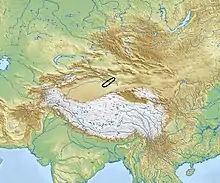 | |
| Geographical range | Tarim Basin |
|---|---|
| Period | Late Bronze Age |
| Dates | ca. 2100–1500 BC |
| Part of a series on |
| Indo-European topics |
|---|
 |
The Qäwrighul culture (after the Tarim Basin cemetery of Qäwrighul , also named 古墓溝 Gumugou in Chinese) is a late Bronze Age culture which flourished along the Kongque River in Xinjiang from ca. 2100 BC to 1500 BC, and is one of the cultures of the Tarim mummies.[1] It is considered as part of the Xiaohe culture, with its Xiaohe cemetery slightly to the south.[2]
Characteristics
The Qäwrighul culture is primarily known for its cemeteries. It is considered as the oldest of the Tarim mummies burial sites, going back to 2135–1939 BCE for its lowest layers.[3] The best attested of these are the cemeteries of Qäwrighul itself, in which at least forty-two burials have been uncovered. Qäwrighul tombs are divided into two types.[1]
The first type of Qäwrighul tomb is characterized by shaft graves. These included evidence of wooden planking. Sometimes, wooden poles were erected on the western and eastern ends of the chamber. The deceased in these tombs were buried in an extended position with their heads to the east. They bore felt hats and were wrapped in woolen fabrics. On their chests, twigs of ephedra have been discovered. Grave goods in these tombs include bone ornaments, antler awls, wooden basins, stone implements, and bowls. Although traces of metal, both copper and bronze, have been discovered, no evidence of ceramics have been found. The physical type of these burials have been connected those of the earlier Afanasievo culture.[1]
The second type of Qäwrighul was characterised by shaft graves surrounded by concentric circles of poles. Other poles radiate out to form what appears to be solar symbols. The burials are exclusively confined to males. The forms of pole circles have been compared to the stone circles characteristic of the Andronovo culture. The physical type of these burials are also similar to those of the Andronovo culture.[1]
The differences of the two types of Qäwrighul burial has been variously interpreted. Some have explained them as belonging to people with different status belonging to the same culture, while others have explained them as belonging chronologically separate cultures belonging to different populations.[1]
The preservation of the bodies range from poor to incredible well preserved mummies. Which is a result of the arid sandy conditions of the area.[1]
From the limited remains of the Qäwrighul culture it appears that their economy included wheat, sheep, goat and horses. Deer and fish have also been discovered.[1]

The burials of the Qäwrighul culture are Europoid.[1] These are the earliest evidence for the presence of Europoid populations in the Tarim Basin. Its burials in shaft-graves, lined with stone or timber, and surrounded by enclosures, and the presence of offering-places associated with the heads and legs of horses, are strikingly similar to the graves of cultures located further west on the Eurasian Steppe.[4] The physical type of the Qäwrighul people is similar to that of people of the earlier Afanasievo culture, and people of the contemporary Andronovo culture.[5][6] On this basis, the Qäwrighul culture has been considered a possible candidate as an ancestor of the Tocharians.[1]
Transmission of bronze technology
Archaeological finds at the Gumugou cemetery have reinforced the theory of the transmission of bronze technology through contacts between the Afanasievo culture and Xinjiang, with further transmission to the Gansu region in northwestern China (Majiayao culture and Qijia culture).[7]
See also
References
- 1 2 3 4 5 6 7 8 9 Mallory & Adams 1997, pp. 473–474.
- ↑ Betts, A.; Jia, P.; Abuduresule, I. (1 March 2019). "A new hypothesis for early Bronze Age cultural diversity in Xinjiang, China". Archaeological Research in Asia. 17: 204–213. doi:10.1016/j.ara.2018.04.001. ISSN 2352-2267.
The Xiaohe culture is known from two key sites, the Xiaohe Cemetery itself (Xiaohe Archaeological Team, 2004; Xiaohe Archaeological Team, 2005; Xiaohe Archaeological Team, 2007) and the cemetery of Gumuguo (Han, 1986; Wang, 2014) in the same region.
- ↑ Zhang, Fan; Ning, Chao; Scott, Ashley (11 November 2021). "The genomic origins of the Bronze Age Tarim Basin mummies". Nature. 599 (7884): 256–261. doi:10.1038/s41586-021-04052-7. PMC 8580821.
Such mummies have now been found throughout the Tarim Basin, among which the earliest are those found in the lowest layers of the cemeteries at Gumugou (2135–1939 bc), Xiaohe (1884–1736 bc) and Beifang (1785–1664 bc) (Fig. 1, Extended Data Fig. 1 and Extended Data Table 1). These and related Bronze Age sites are grouped within the Xiaohe archaeological horizon on the basis of their shared material culture
- ↑ Mallory & Adams 1997, p. 593.
- ↑ Kuzmina 2007, p. 170.
- ↑ Kuzmina 2007, p. 252.
- ↑ JIANJUN, MEI (2003). "Cultural Interaction between China and Central Asia during the Bronze Age" (PDF). Proceedings of the British Academy. 121: 1–39.
the argument for possible Afanasievo-Xinjiang contact based on the finds at the Gumugou cemetery in the north-eastern rim of the Tarim basin would seem reasonable and needs to be kept open for the future archaeological finds. In other words, the possibility for the dispersal of early copperbased metallurgy from the Eurasian steppe into Xinjiang and further east to Gansu cannot be excluded at present and will have to be considered when further archaeological evidence becomes available.
Sources
- Kuzmina, Elena E. (2007). Mallory, J. P. (ed.). The Origin of the Indo-Iranians. BRILL. ISBN 978-9004160545.
- Mallory, J. P.; Adams, Douglas Q. (1997). Encyclopedia of Indo-European Culture. Taylor & Francis. ISBN 9781884964985.
Further reading
- Mallory, J. P.; Adams, Douglas Q. (1997). "Qäwrighul Culture". Encyclopedia of Indo-European Culture. Taylor & Francis. pp. 473–474. ISBN 9781884964985.
- Mallory, J. P.; Mair, Victor H. (2008). The Tarim Mummies: Ancient China and the Mystery of the Earliest Peoples from the West. Thames & Hudson. ISBN 9780500283721.